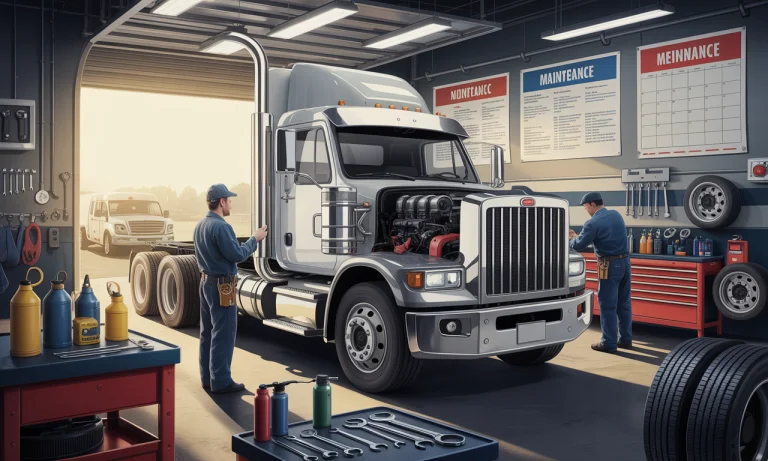Across the highways and backroads of America, the heartbeat of commerce pulses through the engines of trucks both large and small. In a world where 13 million vehicles drive economies forward, understanding essential truck maintenance isn’t just a matter of pride or performance—it’s a lifeline for owner-operators and fleet managers alike. Each year, tens of thousands of new truck owners are tested not by their willingness, but by their approach to maintenance. While most learn by trial and costly mishap, a select few sidestep disaster through knowledge, preparation, and discipline. From tales of roadside saves with a favorite wrench to spreadsheets tracking oil changes down to the last mile, the path to uptime and profitability starts with the basics. As the landscape shifts—with trends like turbocharged engines, stricter DOT compliance, and the integration of parts from trusted names like Mobil Delvac, Cummins, Bosch, Michelin, Goodyear, Caterpillar, and Shell Rotella—the message rings clear: stay ahead or be left on the shoulder. Dive in as we follow the story of Mark and his trusty Freightliner, learning the maintenance lessons that every new truck owner needs in 2025—and discovering how a little preparation makes all the difference.
Building Reliable PM Schedules for Modern Trucks
Mark’s journey into trucking didn’t begin with expertise, but a sense of necessity. Like most, he was overwhelmed by terms from A-Service to DOT annuals and wary of the horror stories echoing through truck stop diners. Seeking answers, Mark discovered that a systematic Preventive Maintenance (PM) schedule was less about complicated mechanics and more about consistency. Mark compared his costs: while friends without a plan often paid over $25,000 a year for repairs, he kept his annual spend near $12,000 by following manufacturer schedules and simple tracking. For every skipped oil change or neglected belt, statistics confirmed the risk: breakdowns increased eightfold and vehicle uptime dropped precipitously. Mark’s approach mirrored the industry shift in modern engine maintenance, where adherence to PM schedules is becoming synonymous with survival on the road.
Understanding Manufacturer Schedules: Freightliner, Kenworth, Peterbilt and More
Every truck tells a different story, and Mark soon realized that what worked for his Freightliner might not suit his neighbor’s Kenworth or that classic Peterbilt still humming through the night. By meticulously following manufacturer recommendations—be it Freightliner’s “A-Service” at 15,000 miles or Kenworth’s alternating PM-A and PM-B regimes—Mark not only extended his truck’s lifespan but preserved its resale value. The nuance in schedules, from medium-duty Isuzu routines to Mack’s MP7/MP8 engine checklists, became his roadmap.
| Brand | Routine Service Interval | Service Focus |
|---|---|---|
| Freightliner | 15,000 miles (A), 30,000 miles (B) | Oil, Filters, Transmission |
| Kenworth | 12,500 (PM-A), 25,000 (PM-B) | Fluids, Brake, Electrical |
| Peterbilt | 12,500 (PM-A), 25,000 (PM-B) | Safety Checks, Lubrication |
Why Preventive Maintenance Outperforms Repairs
As Mark’s confidence grew, he noticed a transformation in his business outlook. No longer reactive, he approached truck ownership with the precision of a seasoned operator. Stories from the road exchanged at rest stops often centered on breakdowns and outages—the unfortunate side of deferred maintenance. Mark’s experience, supported by contemporary studies, underscored a hard truth: every $50 belt replaced on time could avert a $5,000 engine disaster. Using trusted parts from Bosch or maintaining oil integrity with Mobil Delvac and Shell Rotella, he achieved over 96% uptime, cut maintenance costs by up to 60%, and virtually eliminated DOT violations. Preventive maintenance, he realized, was not just about saving money, but about ensuring safety, protecting warranties, and maintaining the integrity of the entire logistics chain—a sentiment echoed in evolving industry perspectives like those found on engine efficiency improvement and turbocharged engine trends.
The Real Impact: Systematic vs Random Maintenance Approaches
Conversing with other drivers, Mark often compared notes about maintenance regimes. He kept meticulous records: oil changes logged, tire pressures recorded with a new Michelin gauge, and every major repair tracked against original manufacturer service bulletins. His neighbor Joe, less organized, faced repeated breakdowns and DOT citations. Industry tables told the rest—96% uptime for systematic approaches contrasted sharply with the 78% rate of less organized peers. The numbers aren’t just statistics; they serve as a daily reminder that processes save money and lives.
| Performance Metric | Systematic PM | No System | Difference |
|---|---|---|---|
| Vehicle Uptime | 96% | 78% | +18% |
| Annual Maintenance Cost | $12,000 | $28,000 | -57% |
| DOT Violations | 0.2/year | 3.5/year | -94% |
Customizing Maintenance: Adapting to Your Real-World Needs
The notion of a one-size-fits-all maintenance plan faded as Mark’s routes took him from winter in Michigan to the heat of Arizona. Duty cycles, environment, and even driver habits influenced the fine-tuning of his schedule. Sometimes, the solution was as basic as switching to Goodyear tires for rougher terrain or using Caterpillar diagnostics on new engine platforms. Mark integrated insights from trucking communities and tech updates from industry leaders, learning that successful operators continually adjust their routines. He tracked fluid specifications, monitored replacement part warranties, and ensured every service ended with a solid record—knowing that a missed filter change could echo years later in lost value or a failed roadside inspection.
What Beginners Get Wrong: Pitfalls and Lessons
Stories spread quickly in the trucking world. Mark watched rookies make classic mistakes—ignoring manufacturer intervals, using cheap substitutes for critical parts, skipping periodic A-Services under budget pressure, or neglecting to log repairs. Many avoided professional shops, attempting DIY fixes without training, especially on complex components like modern Cummins engines. In each case, initial savings gave way to expensive breakdowns, warranty disputes, or worse, DOT non-compliance tickets. Mark found recurring wisdom in industry news, such as technological innovations and future truck trends: staying informed and willing to adapt was as vital as turning a bolt.
Essential Parts and Systems to Monitor
Accumulating years and miles, Mark’s checklist grew sharper. Tires—especially from Michelin and Goodyear—took center stage, inspected before every trip. Brake pads, crucial for heavy hauls, were replaced proactively using reliable Bosch components. Mirrors and headlights, often overlooked, earned their place in his pre-departure routine. Engine oils from trusted names like Shell Rotella and Mobil Delvac ensured each Cummins and Caterpillar powerplant met emission and efficiency targets. And for new electric truck options and eco-trends, Mark referenced reports on EV maintenance cost studies and explored future-ready solutions. Each detail, mundane as it seemed, contributed to a robust maintenance narrative that kept Mark’s rig—and his business—moving forward.
Maximum Longevity: Record-Keeping and Smart Budgeting
During winter, Mark looked back at a year’s worth of records, realizing that disciplined tracking and smart budgeting created margin for emergencies and investments alike. By budgeting $0.15–0.20 per mile for routine costs and setting aside an emergency fund, he could confront surprises without breaking stride. Armed with digital logbooks and modern telematics, Mark’s operation ran as efficiently as the latest connected truck technologies. Comparing notes with peers on future-proof engines and eco-friendly trends at eco-friendly trucking events, he found that systematic, well-documented maintenance was the thread connecting beginners and veterans alike.
| Record Type | Details to Track | Benefit |
|---|---|---|
| Service Dates | Mileage, service description | Warranty, resale, compliance |
| Parts Replaced | Brand, warranty, specifications | Prevents repeat failures |
| Cost Tracking | Parts, labor, total spend | Smarter budgeting |
Frequently Asked Questions
How much does routine truck maintenance typically cost per mile in 2025?
For most rigs under 300,000 miles, expect routine maintenance between $0.15 and $0.20 per mile; older vehicles run higher. On 100,000 miles, plan $15,000–20,000 per year for standard care, with an emergency fund for bigger surprises.
Can a beginner safely perform any maintenance themselves?
Mark found that basics—checking fluid levels, monitoring tire pressure, changing bulbs—are accessible after brief instruction. Complex repairs, especially on modern engines like those from Cummins or Caterpillar, should be left to certified technicians using official parts from brands you trust.
What’s the risk of skipping manufacturer-recommended maintenance?
Ignoring scheduled services often voids warranties, causes premature failures, and jeopardizes DOT compliance. The short-term savings rarely justify the long-term damage—one missed coolant change can snowball into a $15,000 repair and reduced truck life.
How can I tell if I’m paying too much for shop work?
Compare estimates, know baseline costs (oil change: $200–300, brake job: $800–1,500), and ask for parts back. Be wary of upsells or service pitches not clearly required by your truck’s schedule. Reputable shops, especially those handling Bosch, Michelin, or OEM parts, are transparent and organized.
What items should I keep with me for roadside issues?
A basic kit includes oil (from brands like Mobil Delvac or Shell Rotella), coolant, tools, tire pressure gauge, gloves, spare bulbs, and emergency triangles. Only stock what you can confidently use—overpacking with tools for jobs you can’t do is common, but unhelpful.
Did you like it? 4.5/5 (30)







